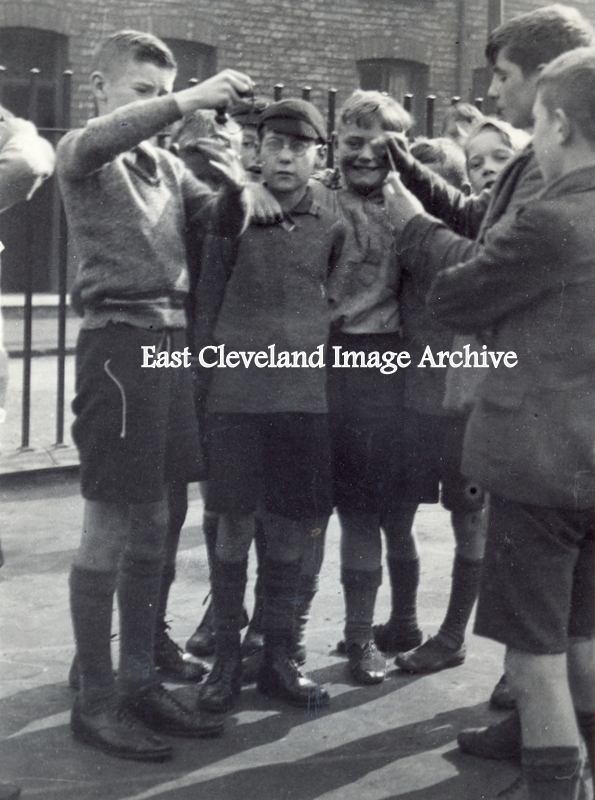
An activity now frowned upon by the ”elf and safety” mob; the pupils of Fleetham Street School, Middlesbrough play conkers about 1938.
Photograph courtesy of Alan Richardson.
|
|
||
 An activity now frowned upon by the ”elf and safety” mob; the pupils of Fleetham Street School, Middlesbrough play conkers about 1938. Photograph courtesy of Alan Richardson. 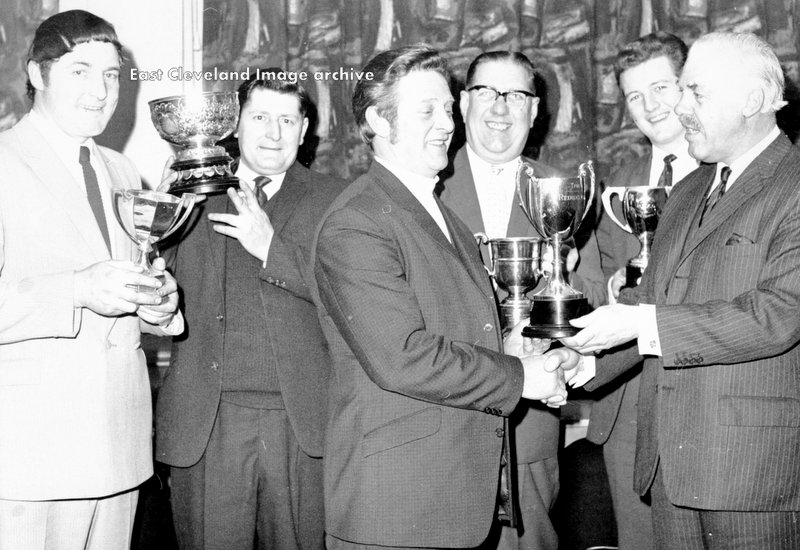 Mr Paul Redway is presenting Brian Cook with a beautiful cup, but what is it for and who are the other men with their cups and what are they for. HELP is definitely needed. Left to right: ??, ??, Brian Cook, Jack Harrison, Colin Sherwood, Paul Redway. Geoff Bailey advised: “I used to live next door to Paul Redway. He lived with his wife, daughter and two sons in the white cottage 98 Belmangate, Guisborough.” Image courtesy of Dave McGill; thanks to Bob Doe for the names and to Geoff Bailey for the update. 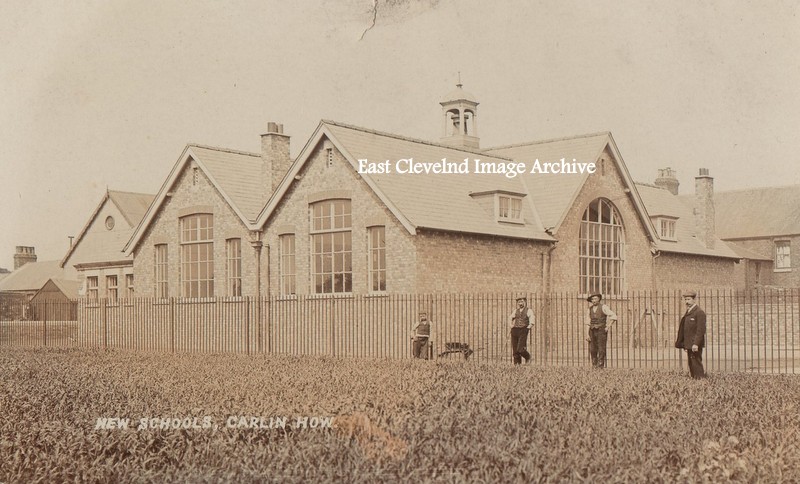 The new school Carlin How opened in 1907, the ceremony was performed by Colonel Legard; Chairman of the North Riding Education Committee. The builder was J. G. Porteus of Guisborough. Bill Kitching tells us: ”I attended Carlin How School when I was three years (Friday afternoons for one hour) then Baby Class at age of five years in 1927. I passed the eleven plus examination in 1933 to go to Guisborough Grammar School. The Headteacher was Miss Keen, Baby Class teacher was Miss Richardson, Class 2 was Miss Birtwhistle, Class 3 was Miss Hall, Class 3A was Miss Stanlake and Class 4 (top class!) was Miss Thompson. Wonderful teachers!” Whilst Derick Pearson tells us: ”I left the same year as Bob but I too remember another teacher who may have left a year or two before. Her name was Miss Keen; who Bill said was there in 1933. But I did not think she was Head Mistress, I’m certain Lena? Thompson was. Did Miss Keen step down? Somethings at the back of my mind about her going to Africa perhaps. Can anyone remember? Miss Keens class was same side and up the Hall from Miss Thompsons, Miss Potters was opposite side and Miss Garners was in the main hall too. Miss Tweddle who came much later was along the corridor in the Annex if I remember correctly. Did she take Miss Keens place perhaps?” Bill Kitching added: “I wonder if there were two Miss Keens? My Miss Keen was Head Teacher in the 1930s. Miss Lena Thompson was from Loftus, where her father was a builder. She played badminton in the Club Hall at Carlin How and her boyfriend used to come to the school on a motorbike and sidecar.” Bob Doe tells us: ”Miss Thompson was still Headmistress when I left in 1957. Other teachers then were Miss Garne r(Class 3), Miss Potter (Class 1) and Miss Tweddle (Class 2) I do also remember the classroom set up as Derick described.” Ian Wilson tells us: ”According to the school logbook Miss Keen took over as Temporary Headteacher on January 6th 1914. Her appointment was confirmed on February 1st. She left on 31st October 1935. During the First World War Miss Keen made many references in the logbook to Zeppelin air raids . On the 6th of April 1916 she recorded: ‘About 2:30am there was an air raid in which the school was badly damaged by a high explosive bomb. The two front cloak rooms and the headteacher’s room were almost demolished and other serious damage done which rendered the school unfit for occupation” It remained closed until May 10th 1916.’ Alan Pearson adds to our knowledge with: ”Miss Thompson retired in 1963, succeeded as Head by Frank Whithers. Miss Potter was still there when I left in 1965.” Image courtesy of Pat Bennison, with thanks to Bill Kitching, Bob Doe, Derick Pearson, Alan Pearson and especially Ian Wilson for the fascinating updates. 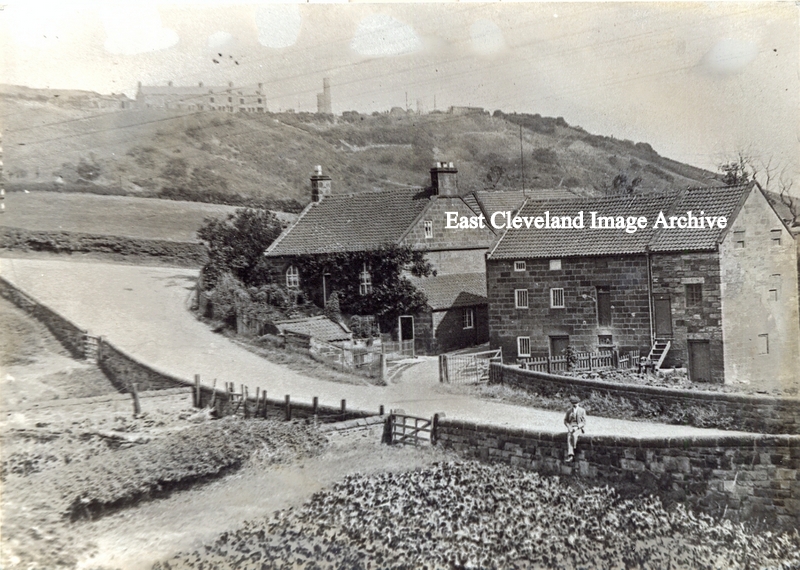
An early 20th century photograph of Kilton Mill. The old road layout at the bottom of Mill Bank is clearly seen, the gentleman sitting on the wall would now be in the middle of the new road; the mill would still be working at this date. Image courtesy of Alan Richardson. 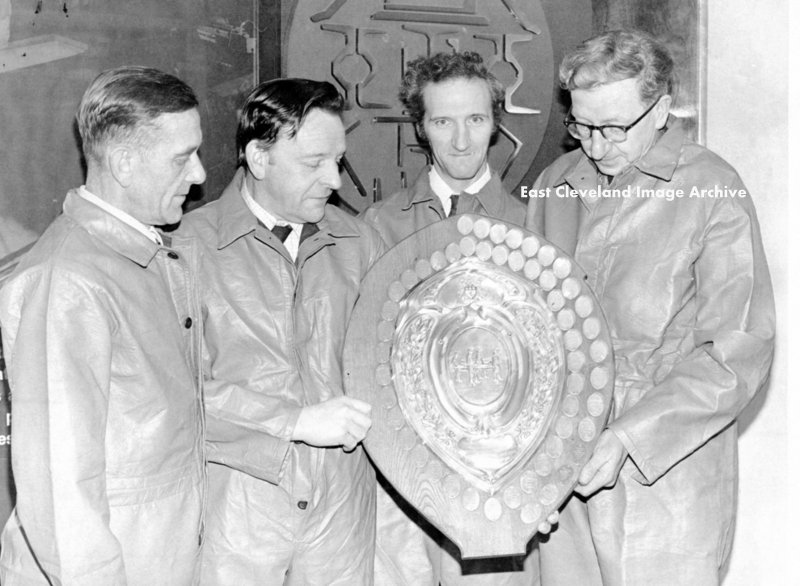 Another shield for the Ambulance section or so I am presuming, Geoff Patton tells us: ”These men were all Safety and Rescue personel as well as the First Aiders; I think they were all in the St John’s Ambulance as well”. Terry Robinson added: “Alec Cuthbert (Senior), on the right.” The names we now know are: Jack Tool, Albert Atkinson, Harold Found, Alec Cuthbert (Senior). Image courtesy of Dave McGill, thanks to Terry Robinson and Geoff Patton for the updates. 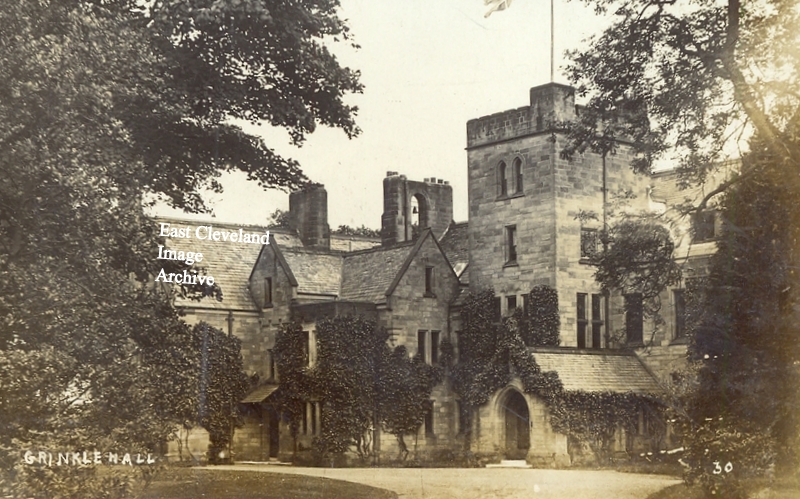 This postcard image of Grinkle Hall dates from when still under the ownership of Sir Charles Mark Palmer, a Tyneside magnate. The hall was built in the 19th century, he controlled iron and coal mines, as well as a Jarrow shipbuilding yard. Locally he developed Grinkle mine and constructed the harbour at Port Mulgrave to export the ironstone to the Tyne. Ann Jackson tells us: ”My great grandmother was a dress maker at the Hall in the late 1800′s. My Grandmothers name was Mary Jackson nee Jordan. She was born in Kendal and came to Easington in the late 1800’s with my Great Grandad James Jackson who was a stone mason working on the Railways. I believe he worked on the tunnel at Easington and also on Paddy Waddells railway.” Whilst Norman Patton tells us: ”William Forbes was my wife’s great grandfather. He was an apprentice gardener in a place near Stranraer and at some point worked for the Beatty Balfours who were plant hunters and particularly concerned with the importing of rhododendrons from the Himalayas. We are quite certain that he was involved with the planting of the rhododendrons at Grinkle Hall after it was rebuilt about 1890s during which time he met and married Mary Welford from Midge Hall, Roxby.” Pat Lawrence asks: “I am trying to find information on Grinkle Hall. My grandfather was head gardener there in the 1800s and my grandmother was a maid. It would be lovely to find some information about the house and workers.” Image courtesy Alan Richardson; also thanks to Ann Jackson, Norman Patton and Pat Lawrence for the updates. 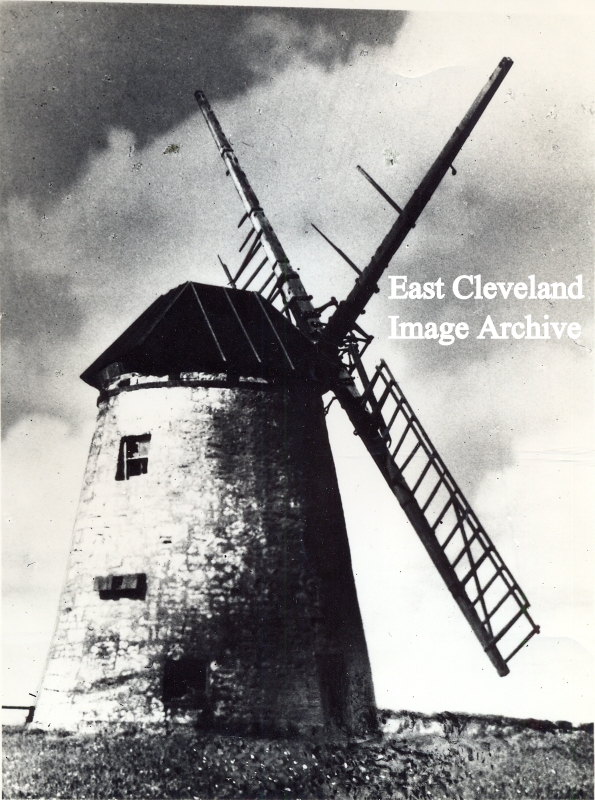 The Windmill at Ugthorpe was erected in 1796 on the site of an earlier structure. A fixed tower mill with automatic fan wheel for turning the unusual cap into the wind. When advertised for sale in 1860 it contained two pairs of mill stones; one French, one Grey. Subsequent owners were Mr C. Walker, Robert Dobson (Senior), Robert Dobson (Junior), Mr Wilkinson; and taken over by Eric Stonehouse of Wakefield. Today it still stands but not as a windmill. Information from ”Yorkshire Windmills” by Alan Whitworth. This photograph taken in 1954 by Alan Richardson, since then the sails and top have gone; it is now a private residence. Alan Gifford has advised: ”Ugthorpe windmill had roller reeling sails, where blind like shutters could be automatically opened and closed, all at the same time.” Image courtesy of Alan Richardson and many thanks to Alan Gifford for the update. 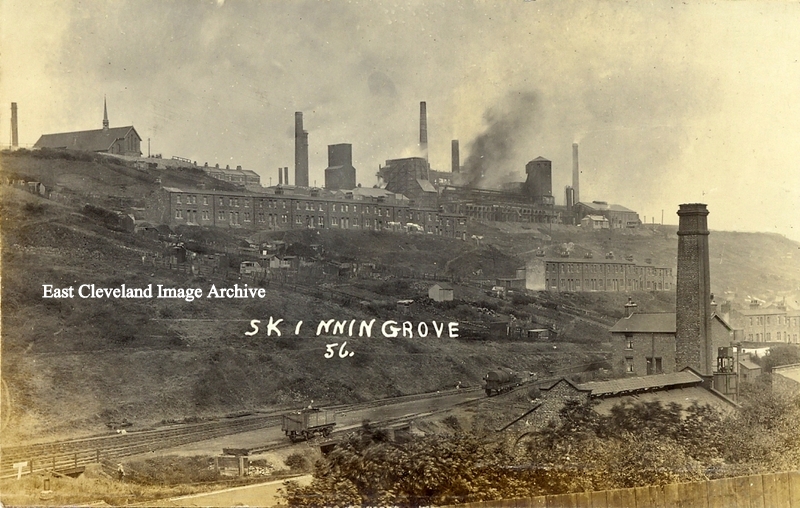 Skinningrove valley and ironworks about 1920. The houses surrounded by industrial pollution from the works, a column of escaping gas can be seen rising from the coke ovens as a retort is emptied. Below in the valley the gas works with a rail tanker on the siding collecting tar produced at the plant. All in contrast with the well kept and tended allotments on the valley sides; at the top left St Helen’s Church completing the scene. Image courtesy of Alan Richardson. 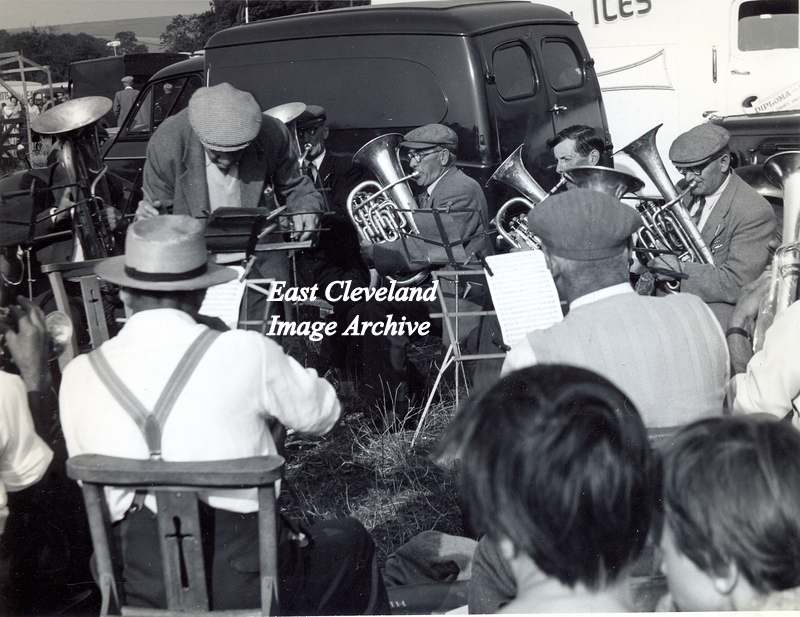 Stape Silver Band at Danby Show 1968. The Band are regular performers at many local agricultural shows. Image courtesy of Alan Richardson. 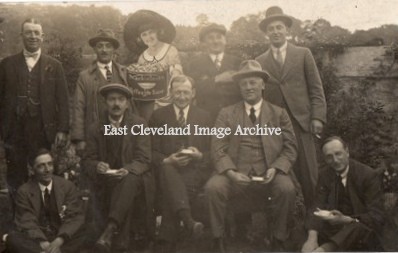 A strange photograph, the lady among the gentlemen appears to be a cardboard cutout! Advertising Mackintosh’s Toffee De Luxe. Julie Riddiough comments: “I have a picture off the RAOB (“Buffs”) taken in what looks like the same place, I still haven’t worked out where it is though!” The location and reason for the deception is one for Sherlock Holmes? Image courtesy of Pat Bennison, thanks to Jullie Riddiough for the update. |
||
Recent Comments